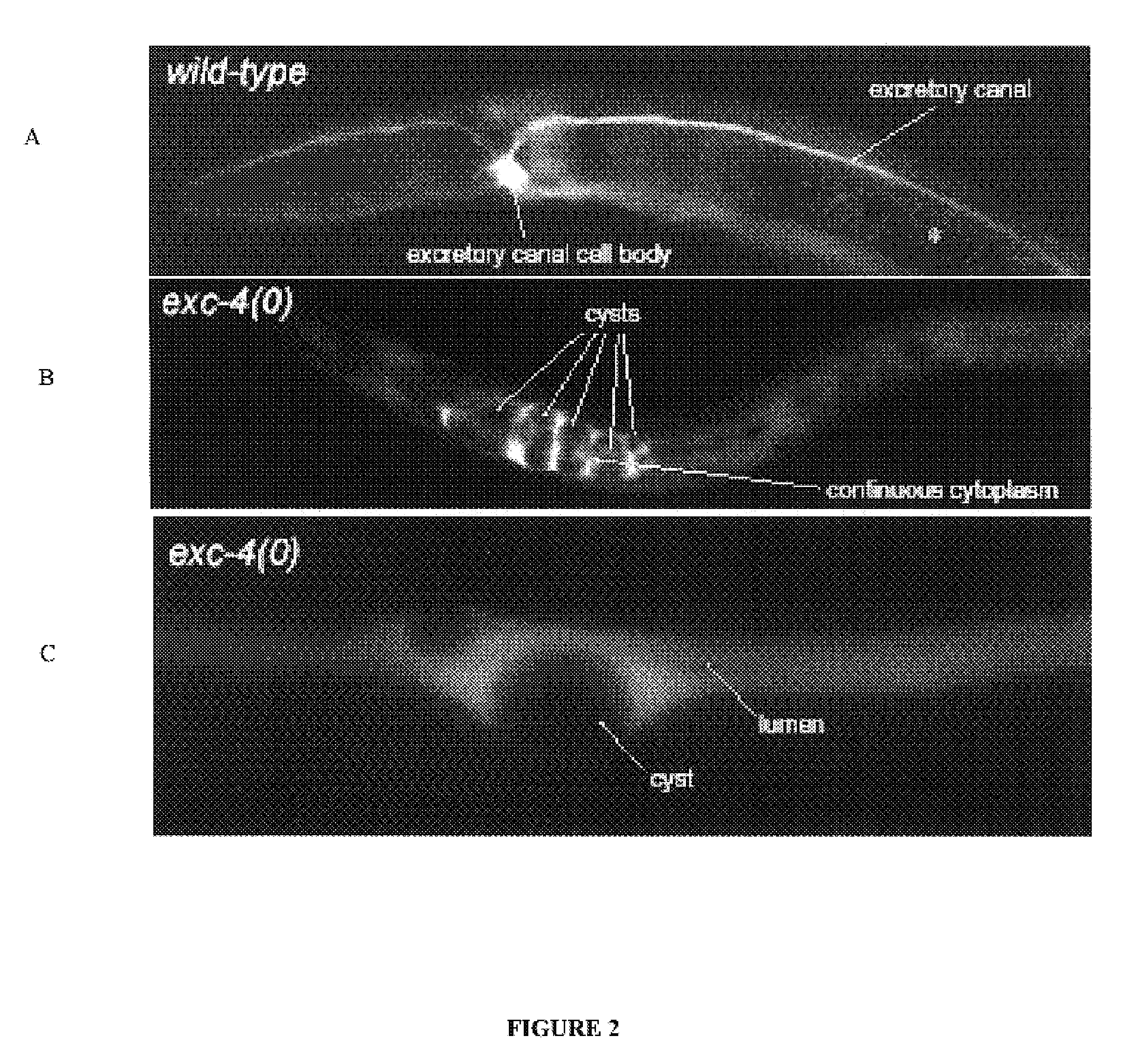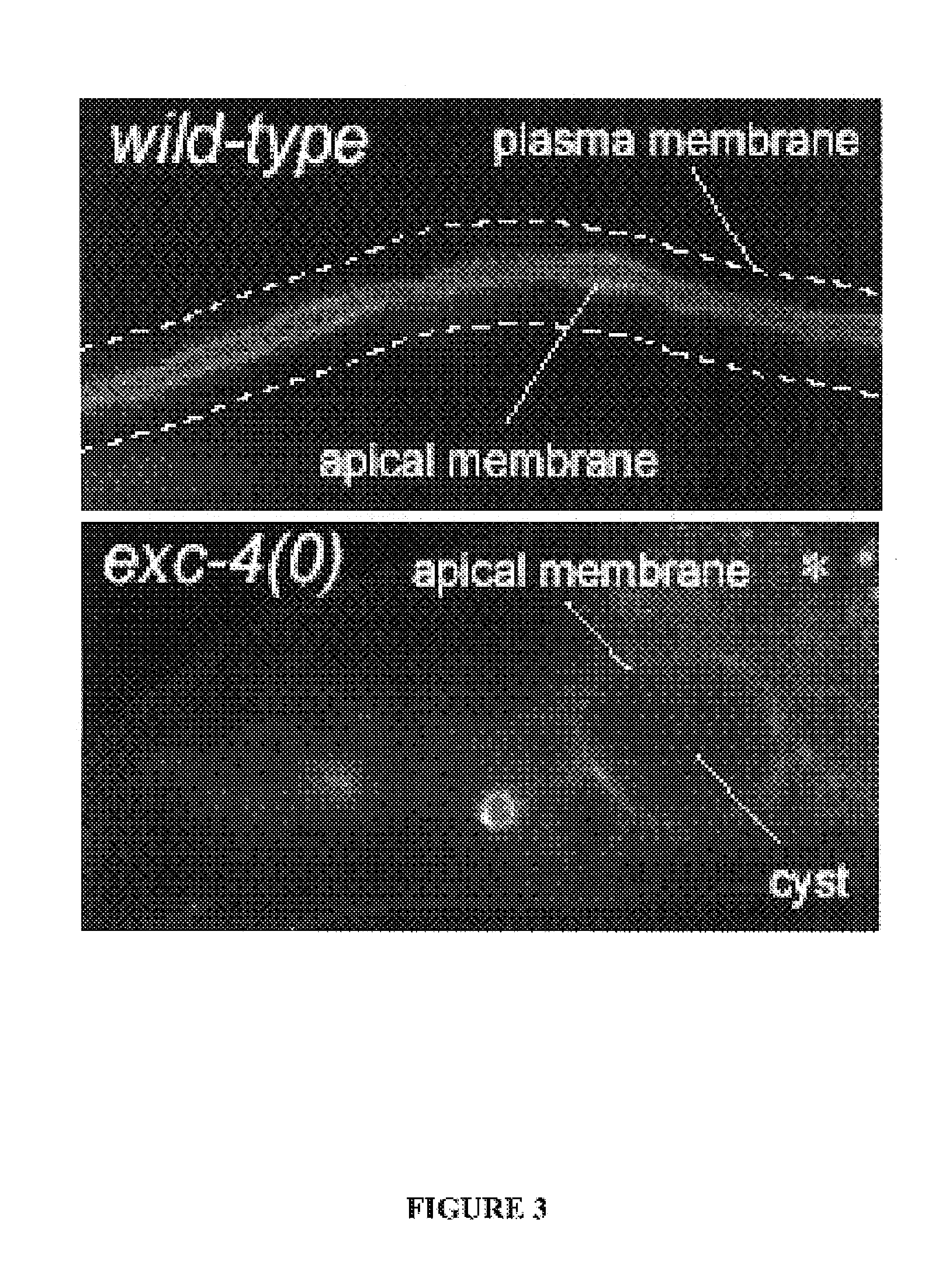Method of screening for agents inhibiting chloride intracellular channels
a chloride intracellular channel and agent technology, applied in the field of isolated nucleic acids for exc4, can solve the problems of not revealing, suggesting or enabling, and lacking the exact in vivo function role of clics, and achieve the effect of inhibiting tubulogenesis and/or angiogenesis
- Summary
- Abstract
- Description
- Claims
- Application Information
AI Technical Summary
Problems solved by technology
Method used
Image
Examples
example 1
[0063]Strains Used
[0064]The following strains were used as indicated. Bristol N2 wild-type; NJ469 exc-4(rh133)I; MT1191 exc-4(n561); MT6169 exc-4(n2400)I; CB30 sma-1(e30)V; SU93 jcIs1: Is[ajm-1::gfp; unc-29(+); rol-6(su1006)] (all from the Caenorhabditis Genetics Center, University of Minnesota, Minneapolis, Minn.); and UG756 bgIs312 (Devgen nv, Belgium).
example 2
[0065]Examination of Exc-4 Morphology
[0066]In exc mutants (for “excretory canal abnormal”) the tubular structure of the excretory cell lumen is disrupted by swellings termed ‘cysts’ that have been proposed to model tubulocystic kidney disease (M. Buechner, et al., supra, Dev. Biol. 214:227–241, 1999). The disruption of tubular morphology in exc-4 mutants has been previously described to be an enlargement of the tubule diameter of the canal's interior lumen marked with partial septa (Id.).
[0067]Using green fluorescent protein (gfp) markers that specifically label either the cytoplasm or the apical surface of the canal, a disruption of lumen structure in the exc-4 null allele rh133 was confirmed (FIGS. 1, 2 and 3). Specifically, in exc-4 mutant animals, the cytoplasmic marker narrowly labeled the septa between cysts and the apical marker labeled the entire perimeter of each cyst, establishing that septa are continuous with cytoplasm and that the entire cystic perimeter is apical in ch...
example 3
[0069]Mapping of exc-4 Locus and Homology Analysis
[0070]The exc-4 locus was mapped using SNP based mapping methods to a 130 kb interval on chromosome one containing seven predicted genes. SNP mapping was done using the Hawaiian C. elegans isolate CB4856. (see, Wicks, et al., Rapid Gene Mapping in Caenorhabditis elegans using a high density polymorphism map, Nat. Gen. 28:160–164, 2001; see also, Wicks and Plasterk, Snip-SNPs: a rapid and powerful mapping tool. Worm Breeder's Gazette 16(1): 28, 1999, and Wicks and Plasterk, snip-SNPs II: Mapping using bulked segregant analysis. Worm Breeder's Gazette 16(2): 24, 1999).
[0071]Generally, recombinant lines were obtained for each mutant exc-4 allele. Strains used were: NJ469 exc-4(rh133)I; MT1191 exc-4(n561)I; and MT6169 exc-4(n2400)I. Each mutant homozygous strain was mated with the highly polymorphic CB4856 isolate, and F1 cross-progeny were picked and individually plated. F2 homozygous mutant DNA was prepared for SNP analysis by lysing a...
PUM
| Property | Measurement | Unit |
|---|---|---|
| concentration | aaaaa | aaaaa |
| nucleic acid | aaaaa | aaaaa |
| length | aaaaa | aaaaa |
Abstract
Description
Claims
Application Information
 Login to View More
Login to View More - R&D
- Intellectual Property
- Life Sciences
- Materials
- Tech Scout
- Unparalleled Data Quality
- Higher Quality Content
- 60% Fewer Hallucinations
Browse by: Latest US Patents, China's latest patents, Technical Efficacy Thesaurus, Application Domain, Technology Topic, Popular Technical Reports.
© 2025 PatSnap. All rights reserved.Legal|Privacy policy|Modern Slavery Act Transparency Statement|Sitemap|About US| Contact US: help@patsnap.com



